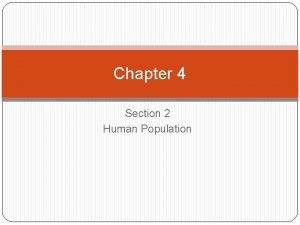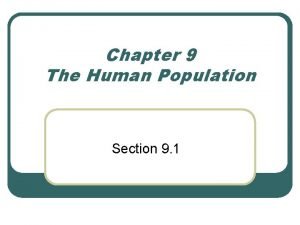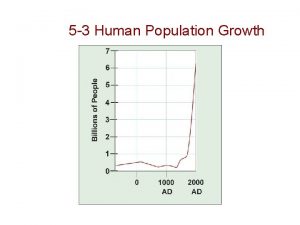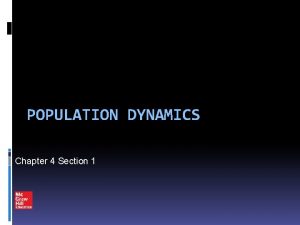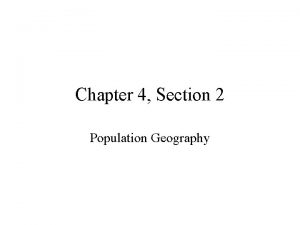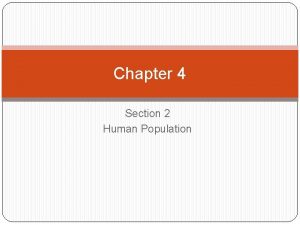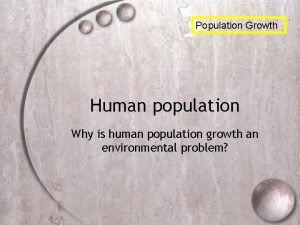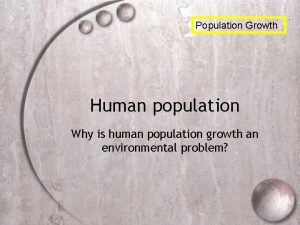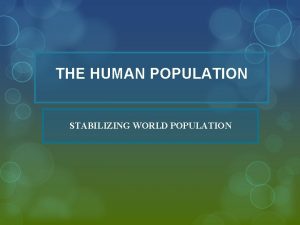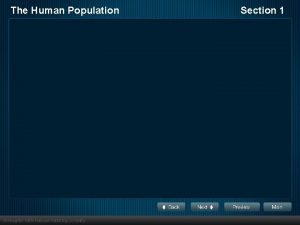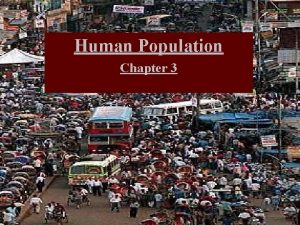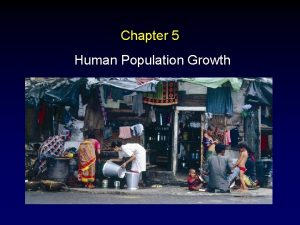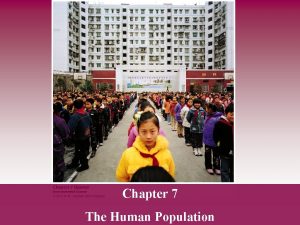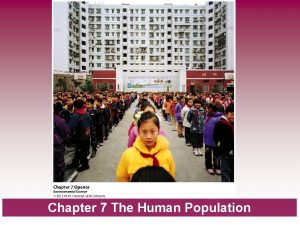Chapter 4 Section 2 Human Population Human Population












- Slides: 12

Chapter 4 Section 2 Human Population

Human Population Growth �The study of populations is called demography �Which includes the following: �Size �Density �Movement �Distribution �Birth & Death Rates

Interpreting the Graph �Graph shows relatively stable populations, until recently. �There has been a recovery after the bubonic plague � 1 billion in 1804 � 6 billion in 1999 � 7 billion in 2012 � 9 billion in 2050

Technology Advances �Environmental conditions have kept the size of our population at a relatively constant number �This has been below our environments carrying capacity. �Humans have learned to alter the environment in ways that appear to have changed it carrying capacity.

Human Population Growth Rate �Even though our population is still growing, the rate at which it is growing has slowed

Interpreting the Graph � Sharp dip in population growth in 1950’s � Population reached its peak at over 2. 2% in 1963 � By 2009, the percent increased had dropped to less than 1. 2% � Population models predict the PGR to be below 0. 6% in 2050 � The decline in population growth is due primarily to disease and voluntary

Trends in Human Population Growth � Population trends can be altered by �Disease & War � Human population growth is not the same in all countries � But trends are often similar in counties that have similar economies. � Developing countries will add more people to the world population as compared to the amount of people added in the industrially developed countries.

PGR% �

Zero Population Growth �ZPG occurs when births plus immigration is equal to deaths plus emigration. �Once this is reached, the age structure eventually should be more balanced �Meaning the following should be equal �Pre-reproductive

Age Structure �The base of a country experiencing rapid growth, such as Kenya is very wide. �Most of the people in a country experiencing negative growth, such as Germany are in later reproductive and post-reproductive stages

Human Carrying Capacity � Scientists are concerned about the human populations reaching or exceeding the Carrying Capacity(CC). � What happens if we do? �Overcrowding �Disease �Starvation � However, technology and planning may be able to keep populations at or below it CC. � An important factor in keeping populations at or below the CC �Is the amount of resources form the biosphere that are used by each person.

Human Use of Resources �Currently, individuals in industrially developed countries use far more resources then those in developing countries. �At some point, the land needed to sustain each person on Earth might exceed
 Chapter 4 population ecology section 1 population dynamics
Chapter 4 population ecology section 1 population dynamics Chapter 4 section 1 population dynamics answer key
Chapter 4 section 1 population dynamics answer key Chapter 4 section 2 human population answer key
Chapter 4 section 2 human population answer key Section 1 population dynamics answer key
Section 1 population dynamics answer key Chapter 9 the human population section 1
Chapter 9 the human population section 1 Section 1 population dynamics answer key
Section 1 population dynamics answer key Population ecology section 1 population dynamics
Population ecology section 1 population dynamics Whats a density dependent factor
Whats a density dependent factor 5-3 human population growth
5-3 human population growth Whats a density independent factor
Whats a density independent factor Chapter 4 section 2 population geography
Chapter 4 section 2 population geography Chapter 10 meiosis 1 and meiosis 2
Chapter 10 meiosis 1 and meiosis 2 Chapter 36 section 2 human development before birth
Chapter 36 section 2 human development before birth


